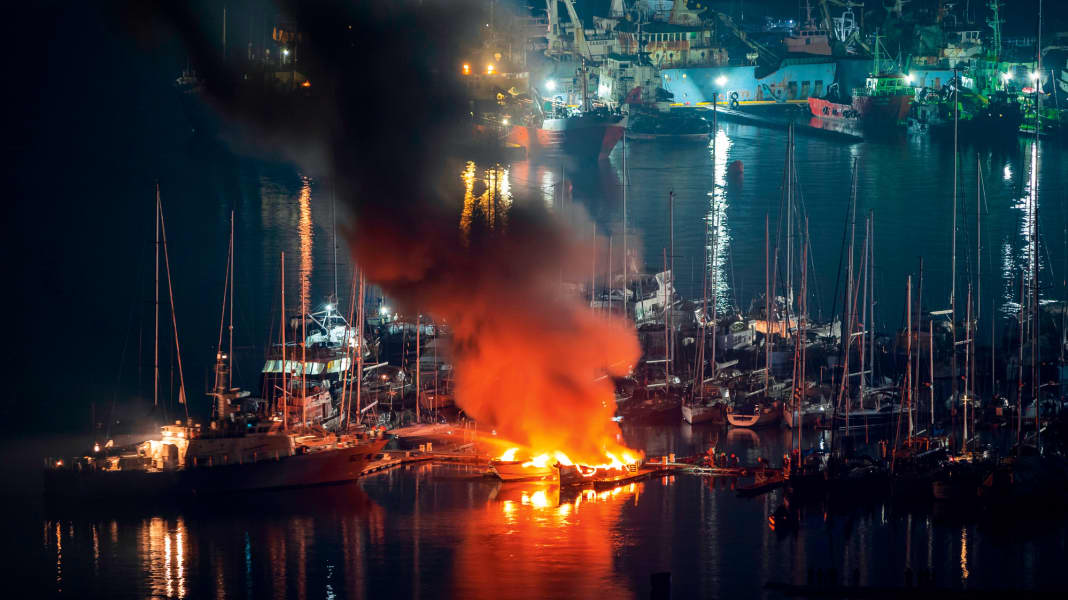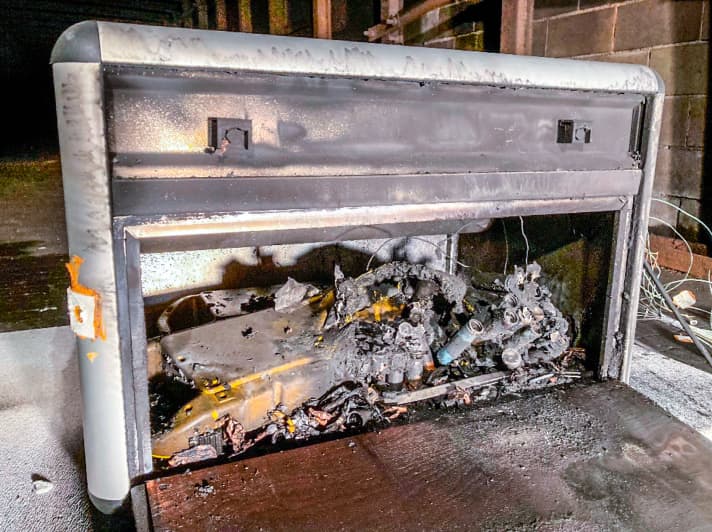Raclan boxes for batteries on board: "Battery fires cannot be extinguished"

Mr Daniel, you are an expert in the field of lithium-ion batteries. How did this come about and where does your in-depth knowledge come from?
In 2017, I was co-owner of a company in Leicester that developed specialised equipment for the police and military. During a meeting with SAS operators, the topic of safe handling of lithium-ion batteries came up. You have to realise that special forces have a very high demand for such batteries and they need the utmost safety when handling them, because after all, they are deployed somewhere in the world and an accident with them not only endangers the operation, but also the lives of the soldiers.

I myself have a long military background and have been working as a consultant for 38 years now, among other things, on all issues relating to physical building protection and the protection of critical infrastructure worldwide. My clients include a number of UHNWI families for whom I have developed security concepts for their properties and superyachts. I hold several patents in this area. This knowledge was very helpful in the development of safe charging and storage containers for lithium-ion batteries, because a thermal runaway causes explosions, flying splinters and very high temperatures.
This year alone, twelve yachts over 24 metres in length were destroyed by fire. That's an alarming number. In your opinion, what is the most common cause of fires on board?
I see three areas as particularly critical: firstly, the galley. Just like in galleys on land, there is an above-average risk of fire here, for example due to overheating of oil or grease, but also due to technical defects in kitchen appliances. The large number of wireless electrical devices on board, such as mobile phones, laptops and radios, is often underestimated. We know from past experience with the Samsung Note 7 or the current global recall of Fitbit's Ionic smartwatches that problems with lithium-ion batteries occur time and again. From January to August 2022 alone, 18 products have already been withdrawn from circulation due to fire hazards caused by batteries.
For me, however, by far the greatest potential danger comes from toys, dozens of which can be found in the garages of superyachts. I also include e-bikes and e-scooters in this category. They have large, powerful batteries that are usually charged and stored without supervision and in areas that are not particularly protected. The risk of a thermal runaway is high here because the toys are handled relatively carelessly. They are subjected to shocks and sometimes fall down. Even if a battery has no visible external damage, cells can be damaged and trigger a fire without warning - even days after it has received an impact. Although modern batteries have battery management systems (BMS) that reliably detect a rise in temperature in the battery housing and interrupt the charging process, this is of no use if the batteries are in a highly flammable area. If a cell fire flares up, it can no longer be stopped.
Have there already been fires on board that have been proven to have been caused by Li-ion batteries from toys?
On 21 October 2022, MSIU reported that the 35-metre yacht "Siempre" had been destroyed by a lithium-ion battery fire. The cause was an electric hydrofoil surfboard. The 36-metre-long "Porrima" was severely damaged by a battery fire, according to a statement from the Indian Coast Guard on 12.8.2022. The 43.70-metre-long "Aria SF" sank on 14.8.2022. Cause of fire: Thermal runaway in a jetboard battery. On 9 September 2019, safety4sea.com reported that "Kanga" was destroyed by a fire that originated in the toy garage.
The greatest potential danger comes from e-toys. Their batteries are usually charged and stored without supervision"
How can a Li-ion battery catch fire?
The most common cause is thermal runaway, i.e. the thermal runaway of battery cells. This uncontrollable exothermic reaction occurs in a lithium-ion battery if it is damaged or a short circuit occurs during the charging process, for example. This affects both old and new batteries. Even those that came straight from production have exploded without warning in the past. That is the problem with lithium batteries: No one can predict if or when thermal runaway will occur. In them, the cathode and anode are separated by an extremely thin polyethylene barrier. If this is damaged, a short circuit occurs, causing materials inside the cell to begin to disintegrate.
These decomposition reactions are exothermic, so that the temperature of the battery quickly rises to the melting point of the metallic lithium and triggers a violent self-heating chain reaction. The cell itself is therefore its own fire accelerator. Temperatures can exceed 1000 degrees Celsius within seconds. This causes the electrolytes in the cells to split into simpler, more easily flammable molecules such as methane, ethane and hydrogen. The cathode also begins to decompose, releasing oxygen. These gases lead to an increase in pressure and temperature in the battery and ultimately to an explosion. One of the by-products of a thermal runaway is the highly toxic hydrogen fluoride (HF), also known as hydrofluoric acid.
How can a Li-ion battery be extinguished?
A burning battery cannot be extinguished. The removal of oxygen does not work, as the battery produces its own oxygen and can catch fire again and again over several days. The only option is to cool the battery permanently. There are special containers for electric cars in which the burning vehicle is placed and then completely flooded with water, supplemented with extinguishing agents if necessary.
Batteries produce their own oxygen and can catch fire again and again over several days"
With your Raclan product, you are offering the first box tested by the German DMT TÜV Nord for the safe charging and storage of lithium-ion batteries. What distinguishes your box from other battery storage boxes on the market?
The special feature of our box is the combination of a fireproof, explosion-proof housing which, due to its special design, does not get hotter than 60 degrees Celsius on the outside, even at internal temperatures above 800 degrees Celsius. A pressurised gas-free extinguishing and cooling system floods the batteries with an environmentally friendly, biodegradable fluid and cools them to such an extent that the reaction of the battery cells is drastically reduced and the thermal runaway is interrupted. A highly efficient exhaust management system filters out all toxins and prevents hazardous gases from escaping into the environment. The Raclan Box has alarm signalling electronics and its own emergency power supply. At 25 kilograms, it is very light and easy to handle. Simply place the batteries and chargers in the box, switch it on and you're done!

How long was the development time?
We started development in 2017 and in 2022 the RACLAN Box was certified by DMT TÜV Nord as the world's first charging and storage box for lithium-ion batteries. During development, we carried out 50 series of fire and explosion tests and destroyed more than 30 boxes in the process. 120 lithium-ion batteries lost their "lives" in the process.

Is a yacht owner or its captain obliged to store batteries from e-bikes and toys on board in safe and fireproof boxes?
No, it is up to the owner and captain to ensure the safety of life and limb of the people on board. There are now international activities on the part of authorities and insurance companies to take mandatory protective measures in addition to voluntary precautionary measures. I am a member of a working group in Berlin, which also includes politicians from various parties, which is looking into this issue and working on proposals for safer handling of batteries.
Is warehousing practised in reality?
There are owners and captains who have told me that the risk is completely overrated and that they see no need for action. In the meantime, these are the exceptions and captains are ordering Raclan boxes directly from us in large numbers. Just this week, a harbour operator with 300 berths ordered the first 35 boxes. He wants to make safe loading and storage in his facility mandatory. The reason for this approach is the risk of causing a catastrophe in the event of a fire. On charter yachts in particular, Raclan boxes are placed in the berths where guests charge their mobile phones or laptops. According to the charter companies, this is very popular.
When does yacht insurance pay for a total loss caused by a battery fire?
There is no general answer to this question. It depends on the policy and what the experts document in their reports in the event of damage. I know of two cases where the insurance companies did not pay for the damage. The reason given for this decision was that the owners were found to have been grossly negligent when charging and storing lithium-ion batteries. Both cases involved damages in the tens of millions. This argument can certainly be followed, as all operating instructions for batteries explicitly point out the dangers and stipulate that the charging process must be monitored in a fire-protected area.
With around 22 million e-bikes in Europe alone, the market for fireproof charging and storage boxes for lithium-ion batteries is huge. You would think so. Did you have support from well-known battery manufacturers during your development work?
When we started development, we contacted many battery manufacturers - we were sure that it would also be in their interest to make the handling of their batteries safer. Far from it. We were met with a predominantly negative attitude. One exception was the company Akku Energie Systeme GmbH (AES). Its managing director Matthias Behlke provided us with dozens of batteries and supported us with a great deal of expertise. They now also use the Raclan Box in their own company. Revonte, an innovative manufacturer of drives for e-bikes, also supported us.
During development, we experienced a predominantly negative attitude from battery manufacturers"
What is the reason for the lack of interest on the part of battery producers?
I think they are afraid that the risks of their batteries will be publicised too much. This is actually complete nonsense, because lithium-ion batteries have become an integral part of our lives. Many devices that make our daily lives easier have these high-performance energy sources. Manufacturers should actively support companies that develop solutions - especially for safe charging and storage. This will at least partially alleviate the discomfort that customers now feel when using lithium-ion batteries. Manufacturers should urgently realise that as soon as legal measures are introduced or insurers impose binding requirements, their reputation will suffer far more than if they work with companies like us.

